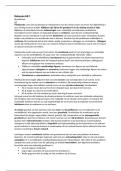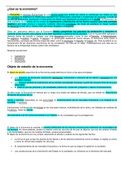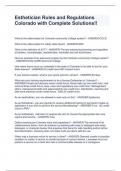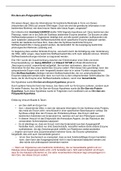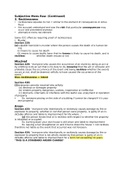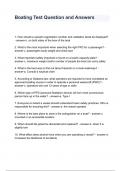TABLE OF CONTENTS
Practical info ............................................................................................................................................................................... 3
Chapter 1: Objectives and functions of financial management ..................................................................................................... 4
1.1 The role of the finance director (CFO) ................................................................................................................................ 4
1.2 The objective of the company from a financial point of view .............................................................................................. 4
Chapter 2: Basic valuation concepts ............................................................................................................................................ 7
2.1 Single amount, to be received or paid afet one year........................................................................................................... 7
2.2 Single amount, to be paid or received after n years ............................................................................................................ 7
2.3 Impact of the interest or discount factor ............................................................................................................................ 8
2.4 Interest periodicity less than one year ............................................................................................................................... 9
2.5 Future and present value of a series of different money flows ......................................................................................... 10
2.6 Present value of a series of equal money flows ................................................................................................................ 10
2.7 Nominal and real interest rates on loans with a periodicity less than one year ................................................................. 11
Chapter 3: Valuation of (bond) loans and shares........................................................................................................................ 13
3.1 Valuation of simple (bond) loans...................................................................................................................................... 13
3.2 Valuation shares based on dividends ............................................................................................................................... 20
Chapter 4: The relationship between the required rate of return and risk .................................................................................. 29
4.1 Lessons from history........................................................................................................................................................ 29
4.2 Determining the risk ........................................................................................................................................................ 29
4.3 Attitutde towards risk ...................................................................................................................................................... 30
4.4 The ‘efficient set theorem’ and risk + 4.6 The effect of diversification: investing in multiple shares .................................. 31
4.5 Calculating the expected rate of return and risk ............................................................................................................... 32
4.7 The capital market line .................................................................................................................................................... 34
4.8 The required rate of return for an individual share........................................................................................................... 34
4.9 Beta as a measure of risk ................................................................................................................................................. 35
4.10 Detecting overvalued and undervalued shares using CAPM............................................................................................ 36
4.11 Alternative models ........................................................................................................................................................ 38
Exercises ............................................................................................................................................................................... 40
Chapter 5: Valuing options ........................................................................................................................................................ 41
5.1 Definition ........................................................................................................................................................................ 41
5.2 Value of an option on exercise date ................................................................................................................................. 41
5.3 Valuation of options: qualitative approach....................................................................................................................... 42
5.4 Valuation of options: quantitative approach .................................................................................................................... 45
Exercises ............................................................................................................................................................................... 50
1
,Chapter 6: Assessing Investment projects.................................................................................................................................. 51
6.1 Determining cash flows ................................................................................................................................................... 51
6.2 Example: an expansion investment .................................................................................................................................. 52
6.3 Evaluation methods ......................................................................................................................................................... 53
6.4 Comparison of net present value and internal rate of return ............................................................................................ 54
Exercises ............................................................................................................................................................................... 56
Chapter 7: Further refinements in assessing the investment ...................................................................................................... 57
7.1 Further refinements in assessing the investment ............................................................................................................ 57
7.2 Capital rationing .............................................................................................................................................................. 58
7.3 Projects with different lifetimes ....................................................................................................................................... 58
7.4 Real options in investment projects ................................................................................................................................. 60
Exercises ............................................................................................................................................................................... 62
Chapter 8: Cost of capital .......................................................................................................................................................... 64
8.1 Basic principles of the cost of capital................................................................................................................................ 64
8.2 Required rate of return on ordinary share capital ............................................................................................................ 64
8.3 The cost of preference shares .......................................................................................................................................... 66
8.4 The cost of debt financing................................................................................................................................................ 66
8.5 The weighted average cost of capital of a company ......................................................................................................... 66
8.6 The required rate of return on an investment project in a diversified company ................................................................ 67
Exercises ............................................................................................................................................................................... 68
Chapter 9: Capital Structure ...................................................................................................................................................... 69
9.1 Maximising corporate value and shareholder value.......................................................................................................... 70
9.2 Modigliani and miller: the capital structure is of no importance in a perfect capital market .............................................. 70
9.3 The impact of corporate taxes ......................................................................................................................................... 74
9.4 Bankruptcy costs ............................................................................................................................................................. 76
Exercises ............................................................................................................................................................................... 80
Chapter 12: Issuing shares......................................................................................................................................................... 82
12.1 Shares ........................................................................................................................................................................... 82
12.2 Organised stock merkets................................................................................................................................................ 91
12.3 Public issue of shares ..................................................................................................................................................... 93
12.4 Rights offering of shares ................................................................................................................................................ 96
12.5 Advantages and disadvantages of a stock exchange listing ............................................................................................. 99
2
,Chapter 13: Financial dept....................................................................................................................................................... 100
13.1 The credit decision ...................................................................................................................................................... 100
13.2 Types of credit provided by financial institutions.......................................................................................................... 101
13.3 Bonds: introductory concepts ...................................................................................................................................... 101
13.4 Types of bonds ............................................................................................................................................................ 102
13.5 Bonds with a call (or early redemption) option............................................................................................................. 103
13.6 Bonds with warrants.................................................................................................................................................... 104
13.7 Convertible bonds ....................................................................................................................................................... 104
13.8 Commercial Paper ....................................................................................................................................................... 107
Chapter 15: Working capital management............................................................................................................................... 108
15.1 The hedging approach to the financing maturity .......................................................................................................... 108
15.2 The impact of the working capital requirement ............................................................................................................ 109
Chapter 16: Cash management and financial planning ............................................................................................................. 113
Chapter 17: Valuation of companies ........................................................................................................................................ 115
PRACTICAL INFO
• Prof. Dr. Marc Deloof
E-mail:
Contact: by appointment
• Assistent: Nina Marien
E-mail:
Contact: by appointment
• Book:
Marc Deloof, Sophie Manigart, Hubert Ooghe, Cynthia Van Hulle
Corporate Finance (2nd edition, 2023)
Published by Intersentia – Bookshops Acco and Universitas
• Teaching methods:
o Lectures
o Practice sessions
• Evaluation
o Closed book, ON COMPUTER
o Multiple choice questions and open questions
o There will be a ‘trial’ exam in early May
3
,CHAPTER 1: OBJECTIVES AND FUNCTIONS OF FINANCIAL MANAGEMENT
1.1 THE ROLE OF THE FINANCE DIRECTOR (CFO)
• Investment decisions
o In which assets should the firm invest?
o Determines size of company – operating results – operational risk
• Financing decisions
o How can/should the firm finance these assets?
o Dept financing (different types of depts (long term vs short term, …))
o What is the best way to fund investments?
o Lots of choices!!
o Determines the fixed financial costs of the company – the financial risk
• Financial planning
o How should the financial flows be managed?
o You’ve got a number of cashflows → how are we going to optimize these? Trade off!
▪ All times cash available to fund things you need to pay (investments, wages, …)
▪ VS you don’t want too much cash, nothing is happening with that money and that’s not good because
it doesn’t bring any profit
• Dividend decisions
o Determines the size of the reserved profits → impact on the equity
• Risk management
o All these decisions above influence the financial risk of a company → management is necessary
1.2 THE OBJECTIVE OF THE COMPANY FROM A FINANCIAL POI NT OF VIEW
• Maximization of
o revenues?
▪ Costs involves → not a good idea
o profits?
▪ What profits? Absolute terms? Profit per share? …?
o Profits per share?
o Value per share?
▪ Include both expected profit and risk!
▪ Risk is not entailed in the other three
• Example: A company has a 20% profitability rate and a profit per share of € 2 (no debts). The company can issue new
equity and invest the proceeds in 10% bonds
o Increase because of the new invested bond
o Profitability goes down because extra money is invested in bonds which only entails 10% → bad investment
because it reduces profitability
4
,• Which objective?
o The creation of shareholder value
▪ Value is not determined by the current profit per share, but by the expected future profits and the
risk associated with these profits!
▪ In an “efficient” market, the market price of a share will reflect its value
▪ Value goes further than just profit!
▪ Earnings per share growth is not necessary good, the interest is value per share
▪ Value per share = expected profits in the future
▪ Earnings per share = dangerous to focus on!
▪ You have to take into account the risk of these profits
o But is value maximization really the objective of companies?
▪ Shouldn’t we also take into account the broader societal context?
o You can maximize your value, but if it doesn’t feel right...
• ESG
o “Environmental, Social and Governance”
▪ Companies should not simply focus on the maximalization of value, but also consider effects on the
company, environment, social issues, …
o “Investors, regulators, consumers and employees are now increasingly demanding that companies should not
only be good stewards of capital but also of natural and social capital and have the necessary governance
framework in place to support this.”
▪ Investors care about the broader impact of the firm
o “More and more investors are incorporating ESG elements into their investment decision making process,
making ESG increasingly important from the perspective of securing capital, both debt and equity.”
• Objectives reporter by companies themselves (2006-2007)
o Looks at the reported goal of the companies for different countries
o What does companies say that their goals are?
o Most companies add several goals where they mention customer satisfaction, employee satisfaction, growth,
profitability, corporate social responsibility
o You can argue that they are not simply focused at making profit!!
5
, o Everything went up, society as a whole became much more important
o Also an increase in care and attention in ethics, ESG environment, ESG social, philanthropy
o Nonfinancial goals are important (BUT that’s what they say, not what they do)
• Which objective?
o But do firms really have an “objective”?
o In this course, we’ll assume that value maximization is the objective of the firm
• Corporate governance
o = How can shareholders make sure that the management of the company will maximise shareholder value?
o Conflicts of interest between the management and the shareholders of a company
o What you as a shareholder want is not the same as what the manager wants
o The agency-theory
▪ The ‘agent’ (manager) acts in the interests of the ‘principal’ (shareholder)
▪ In reality, the interests of the agent can be different from those of the principal
• The agent may care more about his own interests than those of the principal
• The shareholder lacks the information to have a full picture of what the manager is doing
o The manager can use the firm to pursue his own interests, at the expense of
shareholder value
o Other agency-relations in a company
▪ Controlling shareholders versus minority shareholders
• Family firms listed on a stock exchange
• Some of the shareholders are in control over the firm
• Also conflict shareholders vs deptholders (what they want is not the same)
o You want your loan payed back (value of dept) VS you want to maximize value of
shares
▪ Shareholders versus debtholders
• Maximizing shareholder value may be at the expense of the value of the debtholders
▪ Also customers, suppliers, employees and the state have interests in the firm
• Other conflicts!
• For example government want taxes
• This can lead to bad behavior
• One way to diminish conflict to managers and shareholders is by giving them shares
• BUT giving managers stocks also brings a lot of conflicts
6



